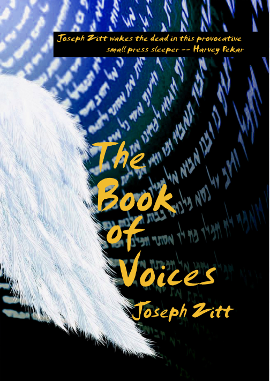The ideas for the book’s cover and for the book trailer video developed together. I asked Travis Dixon to create the images based on the idea of Elisheva’s room and an angel’s wing. He came up with something more abstracted and more powerful than I had imagined.
Travis writes:
Designing the cover for The Book of Voices was a process of trial and error. Mainly errors, really. But those errors led me to discover Blender (an amazing and free-to-use 3D modeling program), where I began playing with its primitives. My modeling experience was limited to an introductory class in Maya many years ago, so my goal was to keep it simple; I’m a fast learner, but I had to be careful with a real deadline. Thankfully, Blender was relatively easy to learn.
Once in Blender, I was able to compose a background for the cover, which was brought into Photoshop. I painted the wing with my Wacom, which consumed much of its own time. Several passes later, I found a mix of color and typography that felt right to me and Joe. The entire process from sketches to finished cover took two months of deliberation and refinement.
After the cover was finished, the trailer needed to be produced. The beauty of Blender made it so that I could use the scene created as the basis for the video, eventually landing on the cover image. Joe provided a treatment to begin with and we tightened it into a script. He was instrumental (pun intended) in getting the music and voices for me, as my full-time job allowed little time for it on my end. I spent a lot of time rendering drafts and working on the camera movement. I brought the final render into After Effects to add filters and titles. Finally, I mixed the music and voiceovers in Soundtrack Pro and married everything together in Final Cut. It was a great learning process, and I’m proud of the result. I’m also happy it’s in service of a book that is both provocative and inspiring.
When I asked him about the stone texture, he wrote:
The stone texture is a free texture I found online. I gave the walls some displacement so it wasn’t perfectly smooth. The lighting was really easy actually — done with the fractal noise filter in After Effects (a basic filter that can be used for dozens of effects). Basically it’s like clouds that evolve and move with variable opacity, giving a subtle but visible effect. It was incredibly minimal but it certainly blended seamlessly.
The Hebrew text moving on the page comes from the Book of Esther. In the original concept of the video, the text would have been swirling across the walls and onto the floor of Elisheva’s room. By Jewish tradition, the name of God would never touch the floor. I knew that the Book of Esther happens not to include the name of God, so I chose it as the text. I found a typeface that would have been in use in the first century CE, copied the Hebrew text of Esther into a document and set it to use that typeface, then sent it to Travis, who proceeded to work his magic upon it.
The spoken voices (in the order that they are heard) are Joseph Zitt, Brian Fending, Fran Carris, Tom Bickley, Bill Stella, Bruce Jennings, and Bob Marsh. We also recorded spoken lines by Matthew Ross Davis, Gail Stuehr, Jessica Robinson, and Lee Batdorff,


Leave a Reply